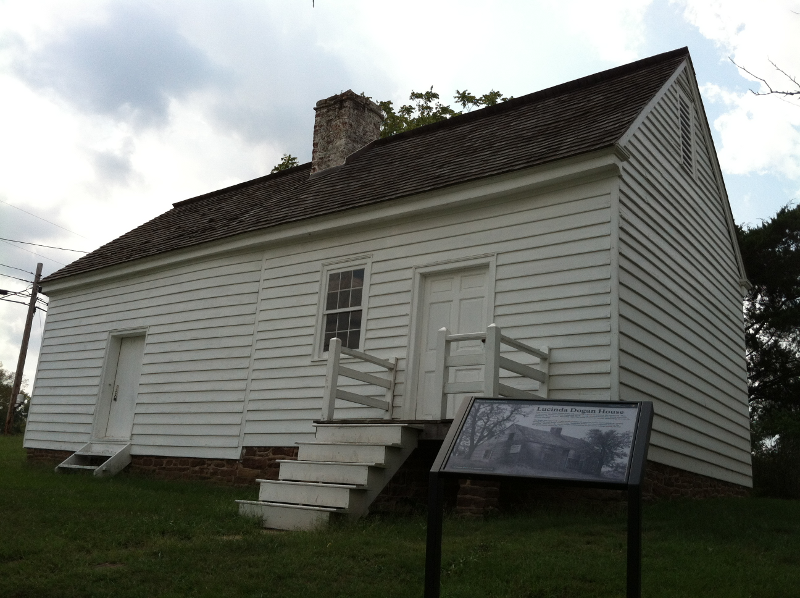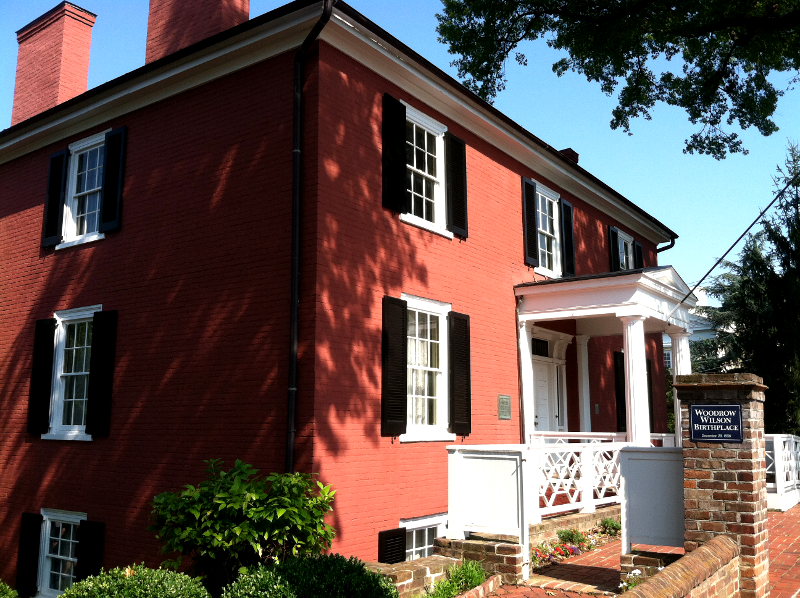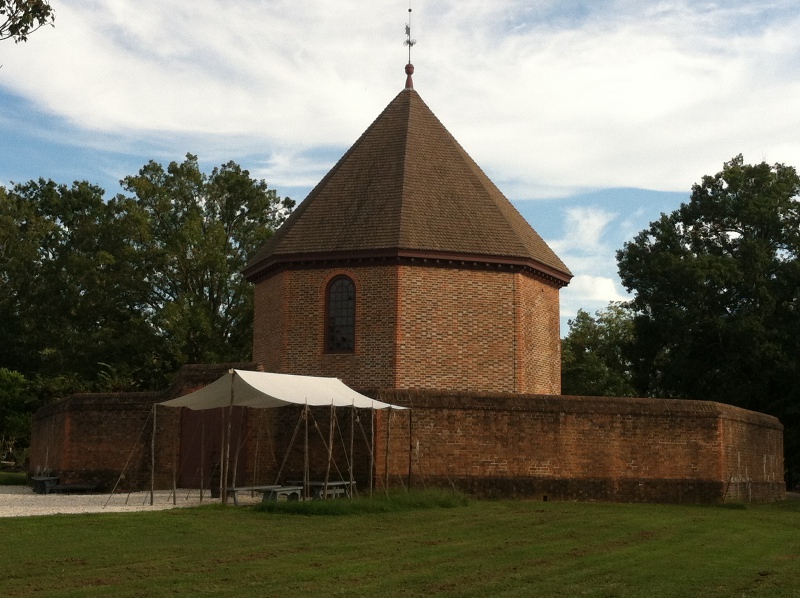
reconstructed powder magazine at Colonial Williamsburg

Visitors spend money, especially for meals and motels. There is a 5% Virginia sales tax on most retail sales (3.5% goes to the state government and 1% goes to the local county or city government, and the last .5% was added in 2004 to support local education - plus an additional 1% sales tax in Northern Virginia and Hampton Roads to fund transportation projects).
Every time a tourist buys something, they contribute to the financing of state and local government via the sales tax. Many communities also have additional meals and lodging taxes. City councils are authorized by the General Assembly to implement those taxes, but counties must obtain voter approval. In 2013, Henrico voters approved creating a meals tax, while voters in Chesterfield County rejected that option. Depending upon where a tourist visits, there may be no free lunch - and no free room either.
Elected officials welcome tourists, even though they can't vote in the community. The Vice-Mayor of Roanoke, Bill Carder, welcomed the Virginia GIS Conference to Roanoke in 2001 with a comment that his city was festival crazy, listing fun activities scheduled for nearly every weekend in Roanoke. He immediately invited everyone to return to enjoy them, and to spend even more money. He got a good laugh - the audience understood the positive economic impacts of tourism. If the city of Roanoke can generate more revenue from sales taxes paid by visitors, then the city council can increase local services or lower the property tax rate paid by residents... and voters.
Hotels and motels have been one of the top business categories paying sales taxes in the state for decades:
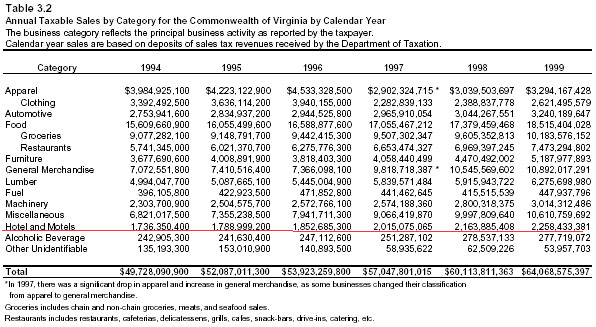
Tax revenues based on tourism has continued to increase. According to the Virginia Tourism Corporation's FY09 Marketing Plan:1
- "Travel and tourism generates $1.2 billion annually in state and local taxes"
- "the amount of tax revenue generated by tourism in 2007 was more than 4 times greater than state tax revenue from cigarette sales in FY2007" and taxes from tourism were "2.9 times what the Virginia Lottery contributed in FY 2007"
- "Virginia is within a day's drive of more than half the nation's population"
- "Virginia is one of the top ten travel destinations in the United States"
- "Canada is Virginia's largest international market"
|
The Virginia Tourism Corporation surveys visitors. Most come to Virginia to visit family, at least in part:
 why people visited Virginia (2011) Source: Virginia Tourism Corporation, FY2011 Profile of Leisure Travel in Virginia To attract visitors to Virginia, the Virginia Tourism Corporation focuses its advertising on selected markets. Most visitors are expected to come from nearby - Washington DC, Baltimore, North Carolina - and from within Virginia. That's the primary market. Those visitors are expected to come for a short getaway/extended weekend. In the Spring and Summer, the state's tourism marketing focuses on families with children, then shifts in the Fall to couples.
The growth market is Philadelphia, New York City, South Carolina, Ohio, and Atlanta. Visitors coming from a greater distance are encouraged to come not only for an extended weekend, but also for a traditional week-long vacation. Marketing research has revealed that trip-related decisions are driven by the female head of household:2
|
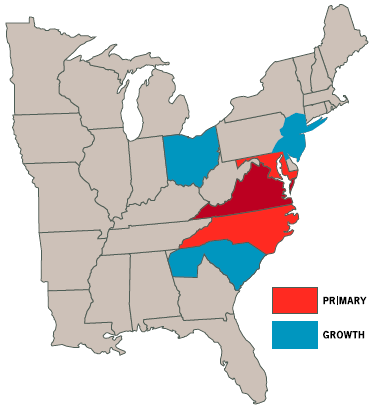 Primary and Growth areas identified by Virginia Tourism Corporation for advertising Source: Virginia Tourism Corporation, Virginia Tourism Corporation Strategic Marketing Plan FY13 |
For a time, marketing efforts by the Virginia Tourism Corporation were designed to stimulate more tourism by using a theme of "Live Passionately," building on the "Virginia is for Lovers" theme that has been so successful since 1969. The FY09 Marketing Plan highlighted the 40th anniversary of that slogan, and also stated:
Elected officials love tourism for a reason - tourists pay lots of taxes, but require few services. Tourists don't require schools, draw welfare, or impose a burden on most social services. The costs of the occasional police call required for a vacationer who drinks too much, and the occasional hospital visit for a tourist who gets sick or hurt, are outweighed by the sales, gas, hotel, and other taxes paid by visitors to the state.
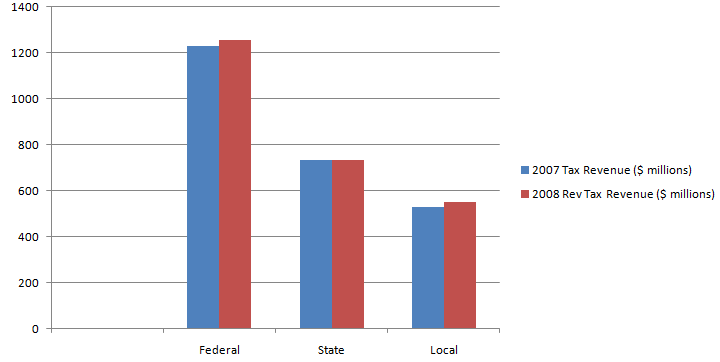
That's why the state and local governments are willing to invest in roads near high-tourism locations, and provide direct grants for tourism attractions. In Williamsburg, there is an extra $2/night tax on hotel rooms. Those tax revenues are used by the Williamsburg Area Destination Marketing Committee for marketing, to advertise the region and attract more tourists.
In the biennial budget process, the General Assembly traditionally has directed the Virginia Department of Transportation (VDOT) to shift about $1 million annually to the Virginia Tourism Corporation for operations of those Welcome Centers. Government in Virginia makes an high profit from tourists, even though many small restaurants and tourism-related businesses may be only marginally profitable and many workers with tourism-related jobs receive close to minimum wage.
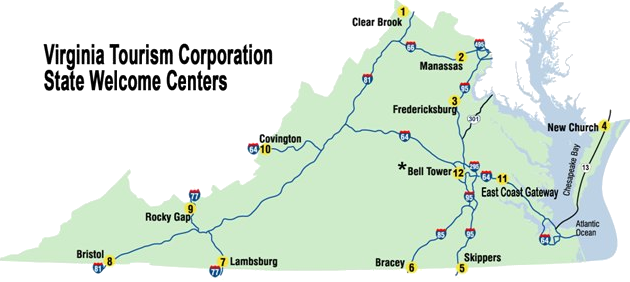
Look at the map of the state's Welcome Centers. Almost all are on the edge of the state, attempting to capture the attention of out-of-state travelers and get them to see more places, stay longer... and spend more money in Virginia. Note that most are on interstate highways, but there is one on Route 13 in Accomack County.
As noted in 1989, when the General Assembly was studying whether to add a second Welcome Center on a non-interstate highway (on Danville Route 29 Bypass, to match the Welcome Center on Route 13 in Accomack County):3
Locating visitor centers is not just an analytical exercise; politics are involved. Why is there an East Coast Gateway Welcome Center in New Kent County, east of Richmond? It was re-opened in 2008, and is now designed to capture tourists on I-64 headed to Virginia Beach and ensure they know about the opportunities to spend money in Williamsburg, Yorktown, and Jamestown, the "Historic Triangle" of Virginia.
The Virginia Tourism Corporation has operated a visitor contact station in the Bell Tower facility on the grounds of the State Capitol in Richmond. There's no parking there, and the number of out-of-state visitors stopping by is very limited. However, the site provides the Virginia Tourism Corporation an opportunity to provide personal service to legislators and their guests during the General Assembly meetings, as well as to visitors walking around the state capitol grounds.
According to the visitor center location map, Route 29 at the North Carolina border lacks a visitor center. The Southern Piedmont is often the area of the state with the highest unemployment rate, due to the decline in tobacco farming and the closure of furniture/textile plants as manufacturing jobs moved to lower-paying regions such as Mexico or overseas.
If the state wants to develop business opportunities based on tourism... why not focus on the Route 29 corridor near the Carolina border? That's what the General Assembly thought, in the 2000 session. It designated funding from vending machine and other "display" profits at highway rest stops, to finance the Center State 29 Visitor Center. Construction of that visitor center helped Danville merchants, especially museums, wineries, and motels.
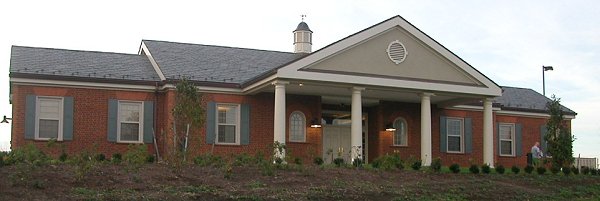
The other oddity about the location of Welcome Centers is in Northern Virginia.
Northern Virginia has complained that the state tourism officials have not used the highway Welcome Centers to encourage tourism in the suburbs of DC. The I-95 visitor center is not on the state's border. It is in Fredericksburg, designed to steer tourists into Central Virginia. That reduces the economic benefits of state-supported tourism in Northern Virginia itself. When the Virginia Department of Transportation temporarily closed 19 of the 42 rest areas along interstate highways during a budget crisis in 2009, only one Welcome Center was shuttered - the Manassas Welcome Center on westbound Interstate 66.
A new visitor center was proposed for Arlington County, off Columbia Pike near the Air Force Memorial. In 2008, the county and the Department of Defense arranged a land trade, so over four acres at the site of the former Navy Annex could be used for an Arlington heritage center and black history museum. A new Virginia Welcome Center could have been incorporated in the facility, to spur a state contribution to the construction costs, but the Defense Department cancelled the land trade in 29012 in order to maximize future burial space at Arlington National Cemetery.4
Natural features, historical events, and festivals can make a place "special." Some places that were not special in any way physically or culturally have been converted into major tourist attractions. The Potomac Mills discount shopping center in Prince William County wasn't even a wide spot in the road, but now attracts over 10 million shoppers annually. Kings Dominion was just a wide spot in the road before the theme park was built. Northampton County and the Chesapeake Bay Bridge-Tunnel upgraded the rest area in the middle of the Chesapeake Bay Bridge-Tunnel.
Busch Gardens had the advantage of being next to a destination resort for families, the Colonial Williamsburg attraction. Now Williamsburg markets vacations to audiences interested in history *and* fun. If you can attract the whole family for a week, instead of just the teenagers for a day, a community can rake in a lot more tax revenue. After all, the theme park claimed the Alpengeist was the world's tallest, most twisted inverted roller coaster.
Good marketing can steer tourists to those places that are already special because of their natural or cultural heritage. The state created the Virginia Tourism Corporation to facilitate tourism to Virginia, after the general "Virginia is For Lovers" campaign was so successful in attracting tourists. The state now targets specific niche markets, trying to recruit visitors interested in outdoor activities (birding, fishing, etc.) and history (colonial settlement, the American Revolution, the Civil War, and now African-American history).
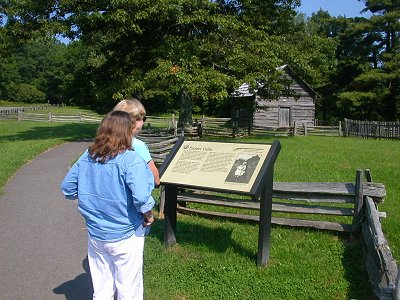 historical cabin on Blue Ridge Parkway | 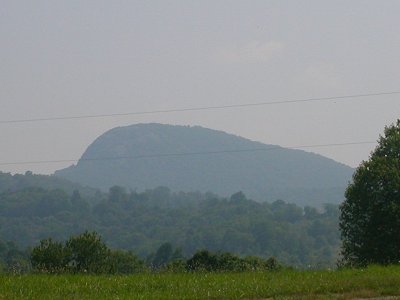 Buffalo Mountain (can you guess at the origin of the name?) |
The state pushed hard to attract visitors for the 400th anniversary of English settlement at Jamestown. Interstate 64 was widened, the south lawn of the state capitol was converted into an underground visitor center, the National Park Service built a new visitor center at Jamestown, and the state version of a recreated Jamestown Settlement just upstream of the historic site (at the ferry landing on the north bank) was upgraded substantially.
One success related to the tourism initiative was subtle but significant. The event was labeled a "commemoration" of what happened 400 years ago, not a "celebration." State officials were sensitive to concerns that honoring the European heritage would trigger a backlash in the Native American community, so extensive efforts were made to incorporate the eight Virginia tribes into planning and presenting the anniversary events in 2007. As a result, there were no national headlines in May, 2007 about pickets at Jamestown complaining about cultural insensitivity, and no national boycott of the commemoration events.
What you saw in 2007 may have been historically valid and perhaps even "politically correct," but authenticity was incomplete. Don't go to Williamsburg and expect to see all the horse manure that was on the dirt streets in colonial times. Flies and smells may be authentic, but they are not attractive... Recreations of colonial living usually are much more hygienic than the real world on the 1600's and 1700's in Virginia. It's even difficult to get interpreters who dress in period costume that can display authentic-looking bad teeth and bad complexions. Not every interpreter is Hollywood-quality gorgeous, but almost all are far more healthy than the historical characters they represent.

Still, tourism to the Williamsburg-Yorktown-Jamestown Historic Triangle has been declining for the last 20 years. In October 2009, a travel research specialist presented to the Williamsburg Area Hotel Motel Association "over 70 graphs and charts showing the same grim trend for hotels across the Triangle – colorful lines pointing down, down, down for the year, in line with national numbers. Unlike the rest of the country, though, the Triangle has been on a gradual downward slide in occupancy for 20 years, with this year the absolute lowest point of all." Tourists staying in timeshares rather than renting motel rooms may be a factor in the decline.5
In response, the Greater Williamsburg Chamber and Tourism Alliance is focused on recruiting business and professional conferences to come to the area:6
The guide for tourism marketing in the Historic Triangle is the 2005 Nichols Report, which noted the vulnerability of the area to a decline in government support for museums, and potentially reduced public interest in history and heritage activities. Recruiting business and professional conferences would diversify the reasons for people to visit, to "complement the current base and engage a broader range of visitor segments" in the jargon or professional tourism consultants.7
